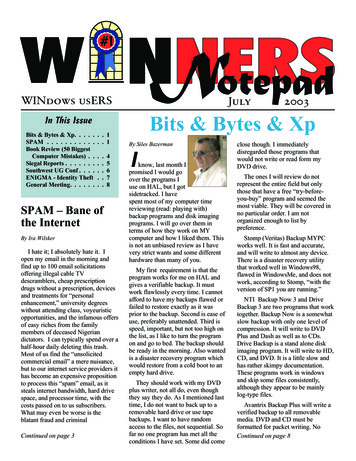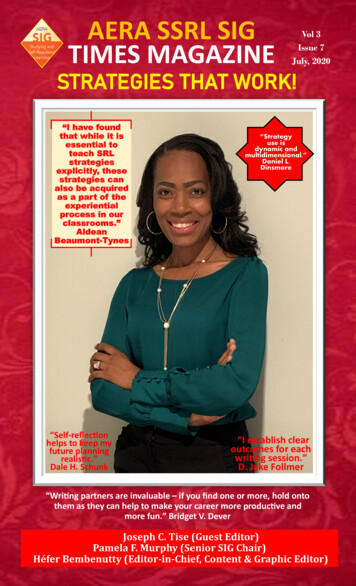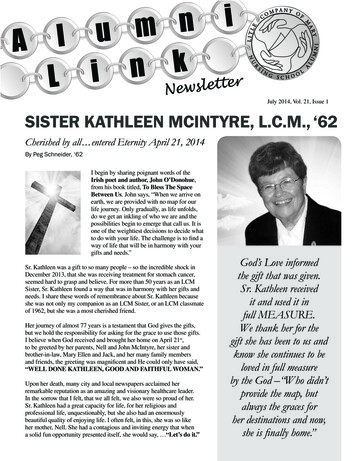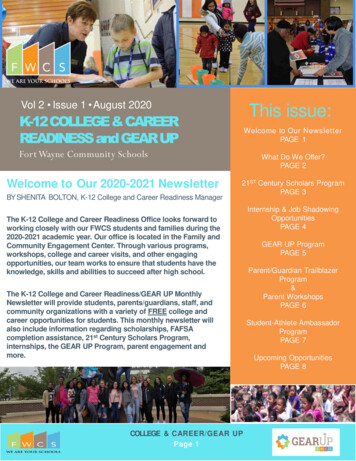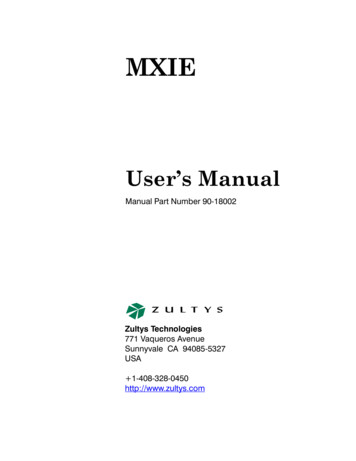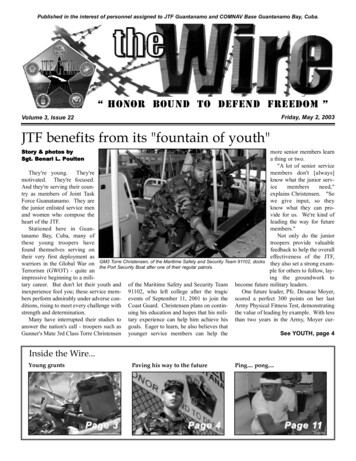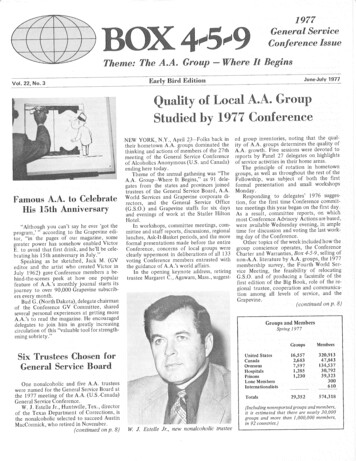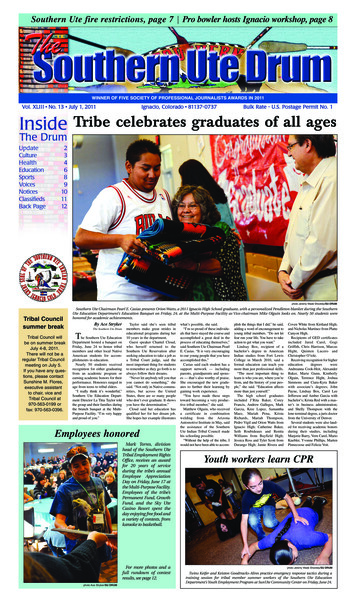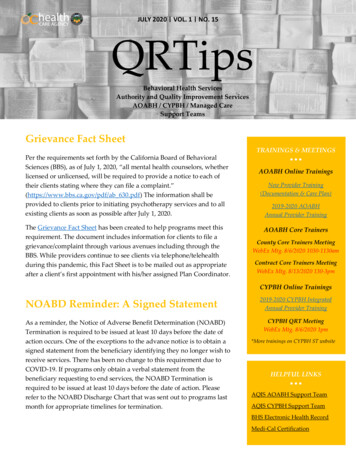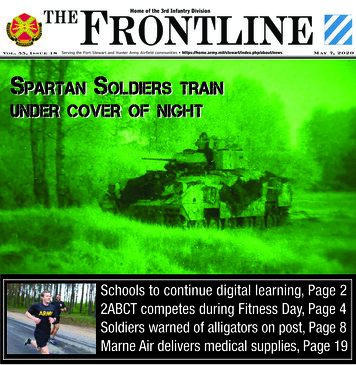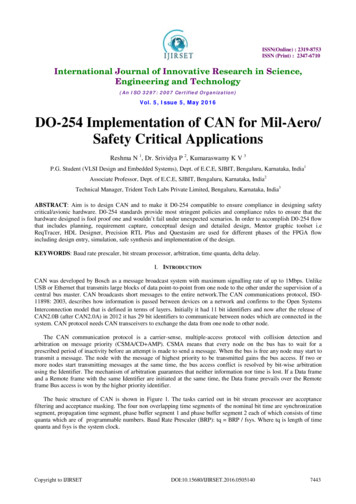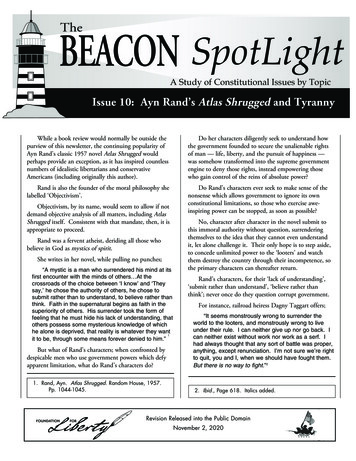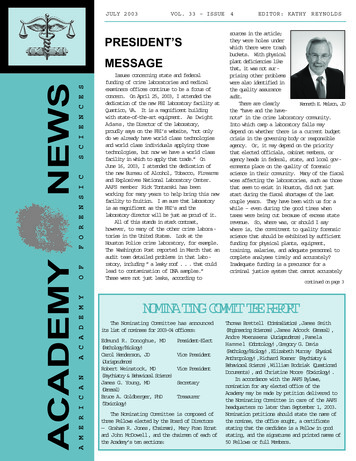
Transcription
JULY 2003VOL. 33 – ISSUE 4PRESIDENT’SA M E R I C A NA C A D E M YO FACADEMYF O R E N S I CS C I E N C E SNEWSMESSAGEIssues concerning state and federalfunding of crime laboratories and medicalexaminers offices continue to be a focus ofconcern. On April 25, 2003, I attended thededication of the new FBI laboratory facility atQuantico, VA. It is a magnificent buildingwith state-of-the-art equipment. As DwightAdams, the Director of the laboratory,proudly says on the FBI’s website, “not onlydo we already have world class technologiesand world class individuals applying thosetechnologies, but now we have a world classfacility in which to apply that trade.” OnJune 16, 2003, I attended the dedication ofthe new Bureau of Alcohol, Tobacco, Firearmsand Explosives National Laboratory Center.AAFS member Rick Tontarski has beenworking for many years to help bring this newfacility to fruition. I am sure that laboratoryis as magnificent as the FBI’s and thelaboratory director will be just as proud of it.All of this stands in stark contrast,however, to many of the other crime laboratories in the United States. Look at theHouston Police crime laboratory, for example.The Washington Post reported in March that anaudit team detailed problems in that laboratory, including ” a leaky roof . . . that couldlead to contamination of DNA samples.”These were not just leaks, according toEDITOR: KATHY REYNOLDSsources in the article;they were holes underwhich there were trashbuckets. With physicalplant deficiencies likethat, it was not surprising other problemswere also identified inthe quality assuranceaudit.There are clearlyKenneth E. Melson, JDthe “have and the havenots” in the crime laboratory community.Into which camp a laboratory falls maydepend on whether there is a current budgetcrisis in the governing body or responsibleagency. Or, it may depend on the prioritythat elected officials, cabinet members, oragency heads in federal, state, and local governments place on the quality of forensicscience in their community. Many of the fiscalwoes affecting the laboratories, such as thosethat seem to exist in Houston, did not juststart during the fiscal shortages of the lastcouple years. They have been with us for awhile – even during the good times whentaxes were being cut because of excess staterevenue. So, where was, or should I saywhere is, the commitment to quality forensicscience that should be exhibited by sufficientfunding for physical plants, equipment,training, salaries, and adequate personnel tocomplete analyses timely and accurately?Inadequate funding is a precursor for acriminal justice system that cannot accuratelycontinued on page 3NOMINATING COMMITTEEREPORTThe Nominating Committee has announcedits list of nominees for 2003-04 officers:Edmund R. Donoghue, MD(Pathology/Biology)Carol Henderson, JD(Jurisprudence)Robert Weinstock, MD(Psychiatry & Behavioral Science)James G. Young, MD(General)Bruce A. Goldberger, PhD(Toxicology)President-ElectVice PresidentVice PresidentSecretaryTreasurerThe Nominating Committee is composed ofthree Fellows elected by the Board of Directors— Graham R. Jones,(Chairman), Mary Fran Ernstand John McDowell, and the chairmen of each ofthe Academy’s ten sections:Thomas Brettell (Criminalistics),James Smith(Engineering Sciences),James Adcock (General),Andre Moenssens (Jurisprudence),PamelaHammel (Odontology),Gregory G. Davis(Pathology/Biology),Elizabeth Murray (PhysicalAnthropology),Richard Rosner (Psychiatry &Behavioral Science),William Bodziak (QuestionedDocuments), and Christine Moore (Toxicology).In accordance with the AAFS Bylaws,nomination for any elected office of theAcademy may be made by petition delivered tothe Nominating Committee in care of the AAFSheadquarters no later than September 1, 2003.Nomination petitions should state the name ofthe nominee, the office sought, a certificatestating that the candidate is a Fellow in goodstating, and the signatures and printed names of50 Fellows or full Members.
PRESIDENT ’S MESSAGE CONT .differentiate the innocent from the guilty through theuse of good scientific methods.The Academy, through the Consortium of ForensicScience Organizations (CFSO), is working on developingthe needed commitment on the federal level. During theweek of May 12, 2003, members of the CFSO descendedon Washington, DC, to meet with representatives of thelegislative and executive branches of government toeducate them on the funding needs for the forensicsciences. Joe Polski, Chair of the CFSO, and Beth Lavash,CFSO’s consultant, met early in the week with theSenators from Minnesota and a Representative on theHouse Commerce, Justice and State AppropriationsCommittee. They also met with the Undersecretary forScience and Technology at the Department of HomelandSecurity. Their message was the importance of financialassistance to the crime laboratories and medical examiners offices around the country, and the nexus betweenthat assistance and quality forensic science produced in atimely manner.On Wednesday, May 14, I joined Joe Polski, BethLavash, the Academy’s representative on the CFSO BarryFisher, AAFS President-Elect Ron Singer, and ASCLDPresident Susan Johns. We met with a staff memberfrom Senator Grassley’s office. Senator Grassley is onseveral budget and finance committees and is also amember of the Senate Judiciary Committee. Ourimportant message to the staff member was that thereare many needs in the forensic science community inaddition to the DNA area. While DNA backlogs and otherissues have to be addressed, so do the backlogs in otherforensic science disciplines.On Thursday of that week, Jamie Downs, representing the National Association of Medical Examiners,joined us at the White House. We visited with DianaSchacht from the Office of the Domestic Policy Counciland Sara Hart, the Director of NIJ. We gave themupdated information on the needs of the forensic sciencecommunity. While we all support the President’s DNAinitiative, consideration has to be given to funding otherareas as well. Susan Johns collected and analyzed information on backlogs in crime laboratories, and pointedout that workload backlogs in the DNA area representonly five to eight percent of the total backlogs in crimelaboratories.With the emphasis on the President’s DNA Initiativeby the administration, pursuing funding in other areaswill be a real struggle. Nevertheless, the CFSO and BethLavash continue to spread our message, a message basedon the collective experience and wisdom of the forensicscience community. Despite some pessimism, you cansee by the smile on our faces as we posed for a picture infront of the White House that we felt it was an accomplishment for representatives of the leading forensicscience organizations to be together in Washingtonspeaking with a single voice.Consortium of Forensic Science Organizations members met with White House officials onMay 15, 2003, to discuss funding for forensic science and medical examiners in the President's2004 budget. From left, Ron Singer (AAFS President-Elect), Jamie Downs (representing NAME),Ken Melson (AAFS President), Susan Johns (ASCLD President), Beth Lavash (CFSO consultant),Joe Polski (Chief Operations Officer - IAI) and Barry Fisher (representing AAFS).A C A D E M YN E W S3
LEGISLATIVE CORNERThe month of May was a busytime for the Consortium ofForensic Science Organizations.AAFS President Ken Melson,President-Elect Ron Singer, and Iwere in Washington along withother members of the Consortiumof Forensic Science Organizationsin our efforts to press for morefederal funding forensic science.Barry A.J. Fisher, MS, MBA Ken’s article discusses theseefforts.I wanted to use this month’s column to discuss theneed for continued advocacy at the grass roots level.Former Speaker of the House Tip O’Neil had a favoriteexpression: “All politics is local.” Of the many visits wehave made to Capitol Hill that refrain rings true.Congressman and Senators ask what their constituentsback home have to say about the need for funding forforensic science. It’s not that they doubt what we aresaying. The fact is that a crime lab director or medicalexaminer from his or her own state carries additionalweight.You may recall that that I reported in the last issue ofthe Academy News that the Administration’s 2004 budgetprovides approximately 200M, but only for DNA-relatedprograms. Funds are not provided for medical examineroffices, nor for other crime lab related areas.Each week I spend some time searching the web fornews stories about forensic science. When I find one, I passa copy on to our consultant Beth Lavash and I sometimescontact the crime lab director from the region the story isabout. We then try to have the director or medical examinercontact Congressmen or Senators from that State. Ourefforts are to press our case that there are many problemsfacing forensic science in addition to DNA typing. Theseefforts seem to be working.Many Academy members have been willing to pick upthe telephone to make a call to key members of Congress intheir own State. A few have even been able to come toWashington to meet with members or their staffs. Letters tomembers also help, especially when a member can write tokey members of the House and Senate AppropriationsCommittees asking them to support the Academy’s position.Some AAFS members may not able to pick up the phoneand make a call because of restrictions placed on them bytheir parent agencies. In such cases, we have asked them tocontact appropriate people in their organizations withwhom we can speak to make our case. In some cases wehave been able to have others place these calls on ourbehalf.If you can help us out, we would greatly appreciate yoursupport.At the 2004 AAFS meeting, we plan on holding a forumon how to affectively advocate for forensic science fundingand to bring you up to date on our continuing efforts. JoePolski, IAI Chief Operations Officer and Chairman of theConsortium of Forensic Science Organizations, Beth Lavash,CFSO consultant, Jamie Downs, and I will lead this forum.We hope you will make time to attend this session andbecome more affective spokespersons for forensic science.On a final note, a long time friend and Academymember, Lisa Forman, is taking a leave of absence from theNational Institute of Justice to take a temporary position todirect medical research on a childhood genetic disease. Lisahas been a major force at NIJ and we will miss her and lookforward to her return. Another Academy member, KevinLothridge, Deputy Director of National Forensic ScienceTechnology Center, will be taking Lisa’s place for a year.Kevin will be a major asset to NIJ during Lisa’s absence andwill take on many of her duties. We acknowledge NIJ’s keyrole in administering federal funds to the forensic sciencecommunity and wish Lisa and Kevin every success in theirinterim positions.ABSTRACT FORM AVAILABLE TO SUBMIT ONLINE!The Call for Papers deadline is fast approaching! Do you have an interesting and educational topic to present atthe AAFS 56th Annual Meeting, February 16-21, 2003, in Dallas, TX? The deadline for submission of all abstracts isAugust 1, 2003. Please submit your abstracts now and keep in mind the meeting theme — “Truth and Justice in theBalance: Forensic Scientists as the Counterpoise.” The AAFS Call for Papers form may be found on pages 21-24 of thisissue of Academy News. HOWEVER, did you know you may also submit an abstract online? The online process is faster,easier, and provides immediate feedback from the AAFS office.What are the requirements? Only that you have an e-mail address to receive your password and future communicationsfrom AAFS headquarters.What are the advantages? You will receive immediate confirmation of receipt of your abstract, the assurance that yourpaper has been received at the AAFS headquarters, and best of all, access to your abstract for editing.Remember, the deadline for receiving your abstract is August 1, so have your abstract and curriculum vitae ready toattach and send electronically. Visit the AAFS website at www.aafs.org, and follow the meeting links to the AAFS Call forPapers Online Form.4A C A D E M YN E W S
PLANNING AND DEVELOPMENTThe Forensic ScienceEducation ProgramsAccreditation Commission(FEPAC) is making steadyprogress in its mission “todevelop and to maintainstandards and to administer anaccreditation program thatrecognizes and distinguisheshigh quality undergraduate andJames P. Hurley graduate forensic science proAAFS Director of Development grams.” With continued fundingfrom the National Institute ofJustice, the Commission met on May 15 & 16, 2003, in theConference/Press Room of the National Institute of Justicein Washington, DC. AAFS President Ken Melson andPresident-Elect Ron Singer, who were in Washington atthe time on other AAFS business, attended the openingsession of the meeting. Ken and Ron commendedCommissioners for their vision and hard work in launchingthe accreditation initiative and offered continued supportto FEPAC members as they moved forward in theirmission.Sarah Hart, NIJ Director, and Lisa Forman, Chief ofthe Investigative & Forensic Sciences Division, NIJ OS&T,made personal visits to welcome commissioners and toextend to them words of appreciation and futurecommitment.The specific reason for this mid-year meeting inWashington was to finalize accreditation standards, policyand procedures, and a self-study and to prepare for thepilot accreditation for Fall 2003. Noting that the NIJsponsored TWGED document was official, FEPACChairman José Almirall affirmed the Commission’sintention to align the accreditation standards and policy& procedures with that document while following AAFSprotocol. Those draft documents will be presented to theAAFS Board of Directors at the Mid-Year Meeting for theirconsideration and review. One final goal of theCommissioners during the two-day mid-year meeting wasto determine which institutions and on-site reviewerapplicants would be selected for the pilot accreditationprocess in October/ November 2003. The six institutions(totaling eight academic programs) chosen for the firstround are Cedar Crest College (Allentown, PA), EasternKentucky University (Richmond, KY), Florida InternationalUniversity, (Miami, FL), Metropolitan State College ofDenver (Denver, CO), Michigan State University (EastLansing, MI), and Virginia Commonwealth University(Richmond, VA).Information about FEPAC (summaries of meetingminutes, list of commissioners, draft documents, etc.) maybe found on the AAFS website (www.aafs.org) at the link“AAFS,” then “Committees,” and then “FEPAC.”Academy members continue to provide textual andtechnical support to Court TV and its “Forensic In TheClassroom” lessons. Five AAFS Fellows (Ken Melson inAlexandria, Brian Gestring in New York City, JenniferA C A D E M YN E W SMihalovich in San Francisco, Adam Negruz in Chicago,and Allan Warnick in Detroit) were on hand at LoewsTheaters in those cities on April 29, 2003, for Court TV’s“Forensics Day” to assure that forensic science information provided by the network to teachers and studentswas both accurate and appropriate. While some aspectsof the DVD-produced brief program were not up toAcademy standards, Court TV officials have expressedtheir strong desire to rely upon the AAFS as the networkexpands its outreach educational activities. Future“Forensics Day” live, interactive telecasts, targeting othersites throughout the US, are in the offing and will buildupon existing lessons. AAFS advisors Tom Bohan,BrianGestring, and Suzanne Bell will continue to evaluatematerials being produced and to monitor progress of theinitiative.There are encouraging signs of another successfulForensic Science Educational Conference. More than 50applications have already been received for the FSEC/UTAwhich will take place on October 17, 18, and 19, 2003, onthe campus of the University of Texas at Arlington.President-Elect Ron Singer, Patricia Eddings, and theConference Steering Committee have finalized the“Schedule of Events.” Lectures, roundtables, and handson workshops will include an overview of the crimelaboratory, forensic pathology, fingerprints, forensicbotany, impression evidence, forensic anthropology,forensic odontology, legal aspects of forensic science,current DNA capabilities and the future of DNA, bloodstain pattern analysis, hairs and fibers, forensic entomology, color tests in the crime lab, and crime sceneinvestigation and processing.Teachers’ essays on why they believe an FSEC willbenefit them and their students are a constant reminderof why this AAFS outreach activity has much merit. Thefollowing comes from a science teacher in Delaware:I teach in an economically depressed area. More than halfof my students are on free or reduced lunch. It's always achallenge to get them interested in their own education, sowhen something comes along that they are really interested inand also meets our state's science standards, I get very excited.All of my students watch CSI and have a high interest in thegenetics/heredity unit. If I can bring home hands-on activitiesthat bring the unit to life, I believe I can make more of adifference in their lives. I'm writing a grant to purchasematerials for the entire seventh grade to support a forensicsactivity.Full information about the FSEC/UTA, sponsored bythe University, Court TV, and the AAFS is available on theAAFS website under the link “Meetings” and then “FSEducational Conference.”It is not too late to attend the Third Annual EuropeanAcademy of Forensic Science Triennial Meeting which willtake place on September 22-27, 2003, in Istanbul, Turkey.The main theme of the conference is "Partnerships AgainstCrime." For further information, please log on to the EAFS2003 website (http://www.eafs2003.org/).5
A WORD FROM YOUR 2004 PROGRAM CO-CHAIRMANThe theme of the 2004 annual meeting is "Truth and Justice in the Balance: Forensic Scientists asthe Counterpoise." With less than a month to the deadline for abstracts, response to the Call forPapers has been outstanding. If you have not submitted your abstract, now is the time! In order toassemble the program in a timely fashion we must adhere to the August 1 deadline. TheAnnouncement and Call for Papers may be found on pages 21-24 of this issue of Academy News. Youare also encouraged to submit your abstracts electronically at http://aafs.org/abstracts/intro.asp.Please submit your proposals for workshops, breakfast seminars, luncheons, and other specialprogram functions as well.The 2004 Program Co-Chairmen and the Program Committee are presently evaluating yourresponses to the surveys conducted at the Chicago meeting. The majority of comments were veryCarol Henderson, JD favorable, other than the sadness of missing some of our colleagues due to the snowstorms whichblanketed the eastern seaboard and the vastness of the hotel facilities. The Dallas meeting locationwill provide a more centralized facility that will accommodate convenient access to all sessions. We still can't figure out how tocontrol Mother Nature, so we'll hope for a mild winter. We received many excellent suggestions from the surveys that we willincorporate in the 2004 program.The Program Committee is ready to receive the rest of your abstracts and proposals. We will be calling on many of you toassist with the review of abstracts. The quality of the program is dependent on your devotion to good science.Mark your calendars for the dates in Dallas, TX, February 16-21, 2004. We look forward to seeing you there!PROGRAM 2004 - DALLASBREAKFAST SEMINAR TOPICS SOLICITEDPresentations for breakfast seminars to be conducted during the AAFS 56th Annual Meeting in Dallas are beingsolicited by Chairman Anthony Falsetti. Because of the popularity of these programs, topics are expected to undergo acareful review and selection process. It is disappointing to turn away potentially excellent presentations because theabstract was received too late to ensure a time
ABSTRACT FORM AVAILABLE TO SUBMIT ONLINE! The Call for Papers deadline is fast approaching! Do you have an interesting and educational topic to present at the AAFS 56th Annual Meeting, February 16-21, 2003, in Dallas, TX? The deadline for
